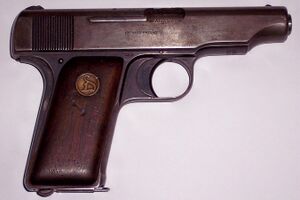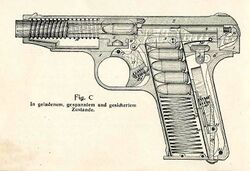Engineering:Ortgies Semi-Automatic Pistol
| Ortgies Semi-Automatic Pistol | |
|---|---|
 Ortgies 7.65 mm semi-automatic pistol with grip safety engaged | |
| Type | Semi-automatic pistol |
| Place of origin | Weimar Republic |
| Production history | |
| Designer | Heinrich Ortgies |
| Manufacturer | Ortgies & Co. |
| Produced | 1919 – 1924 |
| Variants | 2 |
| Specifications | |
| Cartridge |
|
| Feed system | box magazine |
The Ortgies 7.65 mm pistol was a hammerless semi-automatic pistol produced in Germany in the years immediately after World War I, first by its inventor Heinrich Ortgies and then by Deutsche Werke. Inexpensive, but of good quality, the pistol achieved considerable success at contemporary shooting competitions[1] and, as an export product, was popular throughout the Americas.[2]
Design
The pistol was produced in 6.35 mm, 7.65 mm, and 9 mm Kurz variants. Although not expensive, at the time it was of advanced design and high quality construction with relatively few parts, well sealed against dirt. Metal components were forged or machined, and assembly in general made no use of screws, even securing the wooden grips with metal clips, although some examples do incorporate a single screw for that purpose. The hammerless action depended on a spring-loaded striker to fire the cartridge. As in early Colt and Browning pocket pistols, the Ortgies striker also operated as an ejector as the slide traveled backwards after discharge.[1]
Unusual design features included the safety and the magazine. The safety was a lever inset into the back of the grip and, with the gun cocked, forced backward out of the grip into the "safe" position by spring tension from the firing pin upon depression of a button under the slide. Thus, engaging the safety simultaneously reduced tension on the firing pin spring. To disengage the safety, a shooter simply would squeeze the grip, pressing the lever forward and locking it flush with the back of the frame.[1]
At least the earlier Ortgies magazines could accommodate both 7.65mm (aka .32 ACP) and 9 mm Kurz, (aka .380 ACP) ammunition and were interchangeable between pistols of either calibre. One side of the magazine was marked for 7.65 mm and featured seven holes showing the positions that cartridges of that size would occupy when loaded; the other side had similar holes and markings for 9 mm cartridges.[1] Modern replacement magazines are purpose-built for one caliber only.
Production
Heinrich Ortgies designed the pistol while living in Liège, Belgium during World War I.[3] After the war, he moved to Erfurt, Germany, where in 1919 he commenced production of the pistol in his own factory. The weapons bore the mark "Ortgies & Co. – Erfurt" on their slides and a circular brass insert in their grips marked with a stylized "HO." Ortgies died later that year, and eventually production of his pistol passed to Deutsche Werke, a shipbuilding company headquartered in Berlin. For a short time thereafter, the slide marking was changed to "Deutsche Werke Aktiengesellschaft Berlin" before changing again to "Deutsche Werke Aktiengesellschaft Werke Erfurt," ultimately shortened to "Deutsche Werke – Werke Erfurt." Deutsche Werke pistols continued to feature the "HO" brass grip inset until relatively late in their production, when they substituted one with a new trademark depicting a stylized crouching cat with long tail forming an S-curve over its back.[1]
In keeping with prevalent economics in Germany at the time, factory finishes were limited to bluing or, rarely, nickel. The latter finish could be either matte or bright. No Ortgies pistol was produced with a chrome finish or, aside from one known salesman's sample, with factory engraving.[1] Production ceased in 1924.
Performance
The Ortgies was a well-balanced, sturdy weapon that found considerable favor in competitive shooting. In 1921, prize winners at some 70% of principal shooting competitions had chosen Ortgies 7.65 mm pistols, and the winner of the German championship on September 26, 1921, at Halensee, Germany, took the prize firing an Ortgies.[1] At the other end of the user spectrum, outlaw John Dillinger carried an Ortgies,[4] and several hundred Ortgies pistols saw service with Finnish prison authorities through the World War II period.[5]
In popular culture
The Ortgies 7.65 is the pistol that Seymour Glass uses to shoot himself at the end of the short story "A Perfect Day for Bananafish" by J.D. Salinger.
References
- ↑ 1.0 1.1 1.2 1.3 1.4 1.5 1.6 Koelliker, Donald W., "Ortgies: A Well-Known but Little Studied German Armsmaker of the Early Post-War Years," Gun Collector's Digest 1981, accessed April 19, 2010
- ↑ REME Museum of Technology Internet site, accessed April 19, 2010.
- ↑ "Deutsche Werke – Ortgies," Belgian Littlegun Internet site, referencing Ian Hogg and John Weeks, Pistols of the World, accessed April 19, 2010
- ↑ Guns and the Gunfighters, by the editors of Guns and Ammo, New York: Bonanza Books, 1975 (ISBN 0-517-37154-5), dustjacket quoted at Arms2armor Internet site, accessed April 22, 2010
- ↑ Jaeger Platoon: Finnish Army 1918–1945 Internet site, accessed April 19, 2010.




